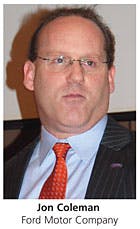WITH growth of 100% each year for the past three years, alternative-fueled trucks aren't just getting traction — they are burning rubber.
Jon Coleman, fleet sustainability and technology manager at Ford, talked about his company's approach to the market, along with the role of upfitters in getting completed work trucks to the customer during an ACT Research seminar presentation March 19 in Columbus, Indiana.
Ford, GM, and Chrysler have all chosen different fuel strategies, Coleman said.
Chrysler chose an alternative fuels path that Coleman described as “manufacturing simplicity.” He said Chrysler wants their vehicles to be as easy to manufacture as possible. They want the highest quality and the highest manufacturing processes in place in order to always know what is going on with each phase of the manufacturing process.
“The result is something we did at Ford about 100 years ago,” Coleman said. “You could have any color you want as long as it is black. If you want a natural gas-powered vehicle from Chrysler, you will buy a Ram ¾-ton crew cab long bed with two CNG cylinders in the bed. You will get a work truck priced at $42,000. It's an interesting strategy, and in the long run, it might be the right strategy.
“For GM, the strategy is customer simplicity. They want to make it as easy as possible for the customer to order it, for their dealers to handle, and for people to get service. It appears to be an OEM solution from GM that actually is done by an upfitter. They are going after what they think is the heart of the natural gas market — work trucks and vans.”
Ford's strategy is to offer natural gas across its product line.
“When we asked our customers what they were looking for, they told us that they run a fleet of mostly ¾-ton trucks, but that they also use Transit Connects, a few vans, and F-650 dump trucks. They said that if they are going to put the infrastructure in place for CNG, they want to be able to use it for every type of vehicle so that they can spread that investment across as many vehicles as possible.”
While spending most of his time talking about CNG, Coleman also said there is a place for propane.
“We most of the interest in LPG coming from shuttle buses, school buses, and in places that are relatively remote,” Coleman said. “If the fleet is based in a place where natural gas isn't piped in, a natural gas compression station is not a very good use of funds. Some states are switching to LPG for that reason.”
Coleman said fleets see advantages in having the ability to run some trucks on CNG and identical vehicles on propane.
“We can put gas in any vehicle we make that is F-650 or lighter,” Coleman said. “The only gap in our portfolio now is F-150, and that's because we are selling more F-150s than we can build. Shutting down a line to set up for alternative fuels right now would not be a good idea. But every other commercial vehicle we have right now is available for CNG or propane.”
Relying on upfitters
Coleman said Ford's approach is complex, both from a manufacturing and customer perspective. At present, the company uses seven upfitters to convert its vehicles for use with gaseous fuels. He does not expect Ford to increase that number.
Although the company offers electric, CNG, and propane as options, not every alternative works equally well. The fuel must match the vehicle, Coleman said. Because of the batteries required, electricity is a better choice for smaller vehicles than for medium trucks. CNG and LPG are better choices for medium trucks, Coleman believes.
CNG faces two key considerations for use as a motor fuel in work truck applications. If the customer is a large fleet that can fuel its trucks at a company-owned location, Coleman said the company could be surprised at how much electricity is required to compress natural gas. And for trucks that need to find fuel away from home, fueling stations are scarce. Gasoline is available in 180,000 locations around the country. Diesel is available in about 20-30% of those, but natural gas can be found in only 1,200 locations.
How big is the market?
Coleman said Ford cumulatively has sold about 26,000 units over the past three years, and has doubled each year. The numbers, of course are small by Ford standards — 3,000 in 2010, 6,000 in 2011, and 12,000 last year.
“We don't expect it to continue to double over the next few years,” he said, “but we don't know where it will level off.
“In an industry that is selling 15 million vehicles a year, 20,000 units isn't something to get excited about. But when you look at the growth potential, that's when you can get excited.”
When asked by the audience, Coleman said the incremental cost for a gas upfit ranges from $9,500 for an F-250 to $13,000 for an F-650. The largest single cost of the upfit is the fuel tanks. Ford's cost to prepare the engine for use with natural gas is about $300. The changes help with two of the realities of CNG use — higher ignition temperatures and the lack of lubricating properties of gasoline. Ford installs hardened valve seats and other hardened components, the exact list of which varies by engine.
“You spend about $300 with Ford Motor Company and about $10,000 with an upfitter,” Coleman said.
Shipping can be an additional cost if the work is done by an upfitter that does not have ship-through capability. Some of these trucks can go to multiple upfitters for products such as telematic systems, fuel systems, as well as standard bodies and equipment.
Relying on qualified modifiers
Ford works with qualified vehicle modifiers (QVMs).
“QVMs do things we aren't comfortable doing ourselves,” Coleman said.
He said Ford evaluates the engineering and production capabilities of a potential QVM company before approving it for QVM status.
“There's nothing that makes calculating total cost of ownership more difficult than having modifications to the vehicle that shorten the expected life.”
Coleman said Ford likes the program because it enables the customer to get a quality high-spec vehicle far more readily.
“This is especially true with emerging technologies,” Coleman said. “As customers point out things that they think will be better for their vehicle, we can incorporate them much faster with this strategy.
“Most CNG pickup trucks have cylinders in the back. Why do you buy a pickup? To put stuff in the back. Putting cylinders back there can mean you can't put a toolbox back there or full sheets of plywood. The number one request we got first from our customers was to put a tank under the vehicle. One of our upfitters figured out how to do it.”
Coleman said that some companies that are not QVM approved can do the work if they comply with the requirements of Ford's Q-185 bulletin.
“As long as upfitters comply with Q-185, we will continue to honor the warranty,” Coleman said. “But we can't attest to their manufacturing processes or their customer support. All we can say is that they have matched a properly prepped engine with the right kind of engine calibration.”
Safety regulations
Coleman pointed out that anyone modifying vehicles to run on CNG must certify that the completed vehicle meets all applicable federal motor vehicle safety regulations.
Workplace safety, however, is dominated by local rules and ordinances. Oklahoma, he said, seems to be at the forefront for updating regulations pertaining to CNG. Until recently, compressed natural gas was viewed much like gunpowder. The old rules required double cinder block walls, and the building must be at least 250 feet away from any other building and 500 feet from any residence.
The state has been bringing rules more in line with the physical properties of the gas, and many state and local governments are adopting what has been written in Oklahoma.
Coleman said some dealers are telling him that it will costs them a half million dollars to make their shops compliant to work on CNG vehicles. He disputes that estimate.
“The only thing I am aware of that dealerships have to do is to address their open-flame heating systems,” Coleman said. “That's the one no-no with natural gas. Don't let it collect and then light a match. Dealerships generally meet modern ordinances.”
Doing the math
Coleman said that a F Series pickup saves an average of $2.621 per year in fuel. If the upfit costs is $10,000, the upfit will pay for itself within four years.
“As you get to larger vehicles, the greater the economic advantages of switching to CNG,” Coleman said. “And the more miles you drive, the greater the economic advantages of CNG.”
The difference in the selling price of CNG and either diesel or gasoline is a third factor affecting the payback period for alternative fuels.
“Right now, all three of these factors are making sense for a lot of people in a lot of applications,” Coleman said. “That's why we have a lot of customers who are coming to us and saying that they want 1,000.”
Coleman was asked how a fleet could be confident that the difference between natural gas and traditional fuels would remain, given the volatility of energy prices.
“There is such a glut of natural gas right now,” he said. “Fleets are signing contracts to lock in prices long-term. If you can lock in your fuel costs for five years on a truck that you plan to keep for four years, there is no risk.”









